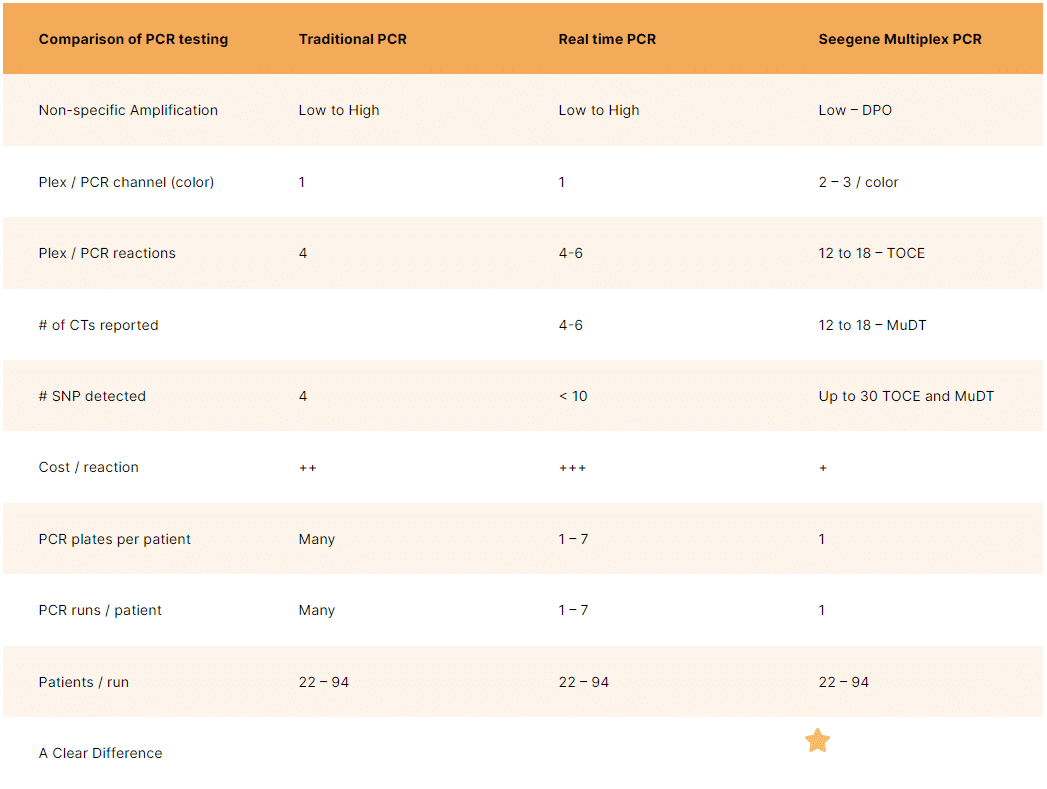
Multiplex PCR tests have shown superior sensitivity and quicker time to result, compared to conventional methods for detection of infectious organisms present in patient samples.
Molecular test technology amplifies target DNA/RNA by over a billion times providing highly sensitive and reproducible results.
Seegene has made important contributions to the field of multiplex PCR testing with the development of DPO™, TOCE™, and MuDT™ technologies. Employed across our various products, these innovations make it possible to detect from among multiple pathogens in a single PCR channel, increasing the total number of candidate pathogens in a single PCR reaction, compared to standard practice.
Seegene’s technologies are uniquely valuable when identifying the causative pathogens of various infectious diseases, including genetic variants, and across a broad range of titers. Because only a single reaction is required to detect multiple targets of interest, testing is made quicker and more cost-effective by reducing the number of PCR reactions, reagents, hands-on time, and plates used.
DPO™ are primers made of two portions that work together to ensure highly specific hybridization, minimizing dimer formation. The DPO™ primers system is a highly accurate, rapid, and cost-effective method of primer binding. It allows for the detection of many targets in a single PCR reaction and is well-suited for high multiplex real-time PCR technology as it can overcome the limitations of conventional multiplex assays that include low plexing (4-6 targets) per reaction and reductions in specificity due to primer-dimer formation.
- Enables highly multiplex chemistries by minimizing non-specific amplification
- Maximizes specificity and sensitivity
- Prevents primer competition and non-target amplification where primer might bind to itself (hairpins) or to other primers (dimers).
- Withstands a wide range of annealing temperatures
- Accurate, rapid, and cost-effective method of primer binding
- Allows the detection of many targets in a single reaction
CONVENTIONAL PCR
DPO™ PCR
Non-specific priming
Dual-specific priming
Decreased Specificity
No dimer formation – High Specificity
Decreased Sensitivity
High sensitivity
Difficulty in optimization
Tolerant to annealing temperature variation
Limitations in multiplexing
Reliable Multiple Target Amplification
TOCE™ technology allows for the detection and differentiation of many targets in a single fluorescence channel using catcher-melting temperature analysis (CMTA). The key components for TOCE technology are a DPO primer (providing high specificity), a pitcher (tagging oligonucleotide which hybridizes specifically to the target region) and a catcher (dual-labeled artificial template). Up to 10 targets can be detected with five fluorescence channels in a single reaction (5 channels) with the same sensitivity as single-plex real-time PCR. TOCE™ provides accurate and reliable results under various assay conditions, when compared to the capability of conventional real-time PCR that requires more reactions to achieve high multiplex testing.
- High multiplex in a single channel
- Up to 5 channels per reaction
- Multiple quality check steps for accuracy
- Specificity is highly maintained across a wide range of annealing temperatures and in the presence of a high concentration of non-target DNA
MuDT™, multiple detection temperatures, enables determination of individual Ct values for multiple targets in a single detection channel. With MuDT™, a standard five channel system can detect up to 15 targets and their associated Ct values supporting both high multiplexing and quantification without additional melting curve analysis. MuDT™ technology combined with DPO™ and TOCE™ differ from conventional PCR where only a single Ct value is determined in each channel.
- Multiple Ct (threshold cycle) values in each fluorescence channel
- Simultaneous detection, discrimination, and quantification of multiple targets in each channel of a single reaction
- Each Ct value of multiple targets present in a sample is equivalent to that obtained by single target amplification
- SNP genotyping in a single channel

Novaplex™ Assays are For Research Use Only. Not for Use in Diagnostic Procedures.
